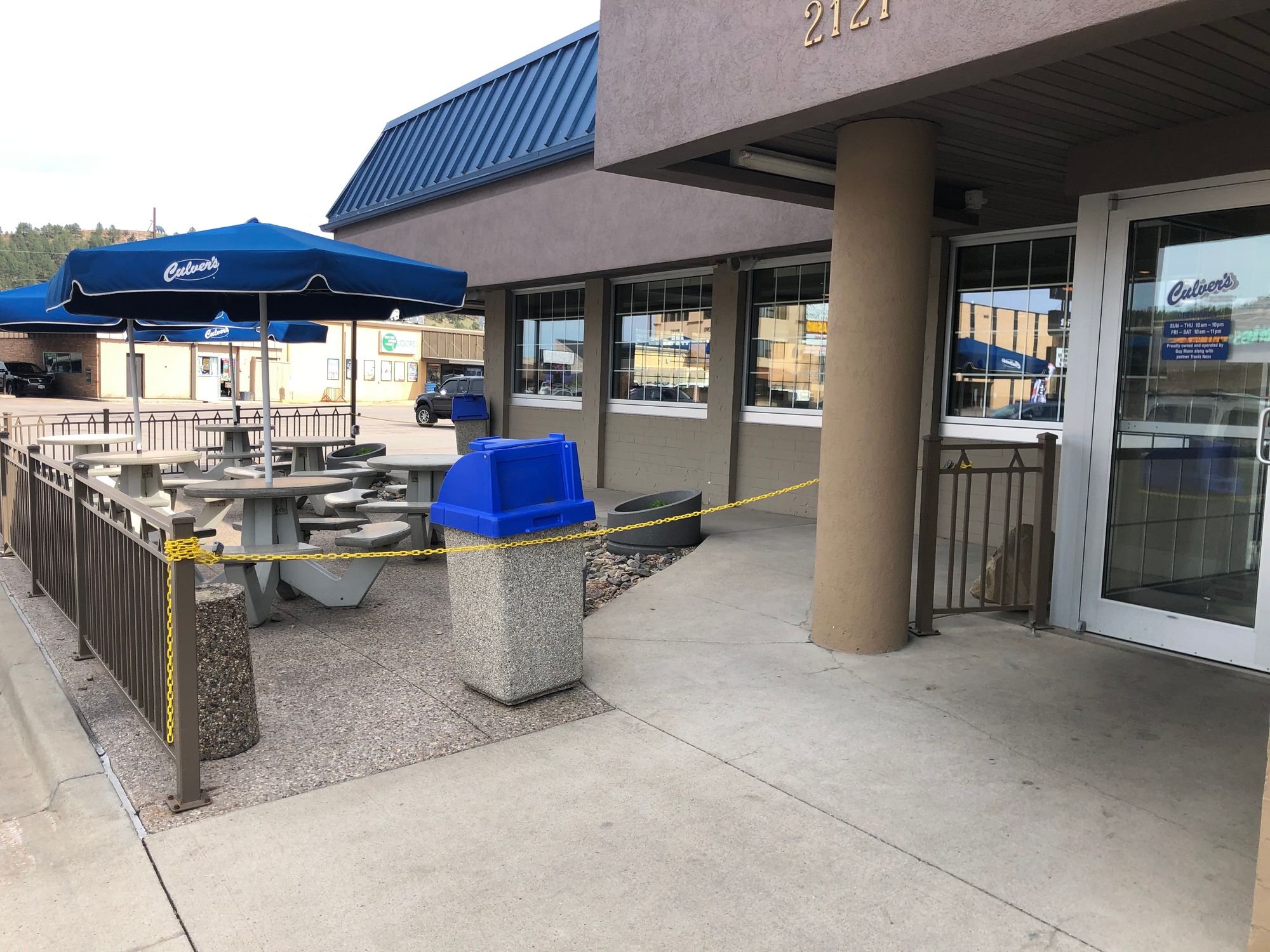Stacey Twiggs is one of the “uncounted” unemployed people in South Dakota.
Twiggs, 35, is a massage therapist from Black Hawk who has seen COVID-19 turn her life upside down. She hasn’t gotten sick, but the pandemic has destroyed her once-thriving business, forced her to live off credit cards and put her in fear of becoming homeless.
And yet, Twiggs isn’t counted among the record number of people who are officially listed as unemployed in South Dakota amid the pandemic, and she is not able to obtain unemployment benefits.
Twiggs is one of an unknown number of South Dakotans who are out of work, but who cannot get state unemployment benefits because they were self-employed or did not qualify for any reason. These uncounted, unofficially unemployed workers are suffering from a loss of income but do not have easy access to government assistance, and some are turning to charities or friends for help.
With state unemployment benefits unattainable, Twiggs and others have tried to get help from federal emergency programs aimed at helping the jobless stay afloat. But applying for those programs must be done through the South Dakota Department of Labor and Regulation and can be complicated. And because the state has been fielding more than 5,000 new applications for benefits each week, actually getting money can take some time.
“It’s been a crazy, wild adventure trying to get help,” said Twiggs.

As many as 14 million Americans who could qualify for some type of unemployment compensation are not receiving assistance, according to a survey published April 28 by the Economic Policy Institute.
According to the survey, some workers were stalled by complicated paperwork or frustrated with overworked state labor agencies. Others were paid under the table or didn’t make enough money the year before seeking benefits to qualify for compensation.
The high number of uncounted unemployed people has led government officials to understate the depth of the employment challenges in South Dakota and the nation, and could have implications in regard to creation of emergency programs or funding initiatives to aid those who have lost their livelihoods.
The ability to craft meaningful, well-targeted assistance programs is also hampered by a lack of data collection by government agencies, including in South Dakota, where officials don’t track unemployment by age, gender, race, industry or location.
Federal surveys that look at some of that information are conducted only once a month. The March federal survey missed the initial surge of new virus-driven unemployment claims; the April survey is expected May 8.
By excluding people from official employment data, the state is not presenting an accurate picture of overall unemployment to the public and policymakers, said state Sen. Ryan Maher, R-Isabel.
“You’re fudging the numbers; you’re not being truthful about the situation,” Maher said. “They always say South Dakota’s unemployment rate is 2% or 3%, but even before the virus hit, your unemployment rate was probably closer to 10%.”
The lack of good data has “skewed” the state’s ability to accurately track unemployment and fully understand what is happening in the marketplace, said Maher, the owner of an insurance agency who sits on the Senate Appropriations Committee. That could affect the state’s ability to help people or react in a crisis, Maher said.
“You wonder, what does that population look like that is falling through the cracks and not being tracked?” Maher said.

“You wonder, what does that population look like that is falling through the cracks and not being tracked?” -- Sen. Ryan Maher
No one really knows what the total unemployed population actually looks like in South Dakota. The state does not track people who don’t get benefits or those who are considered to have left the labor force.
Based on the number of continuing recipients and new claims, about 6% of the state’s labor force of around 467,600 was either seeking or receiving unemployment benefits by the end of April. The number of people seeking or receiving benefits was nearly double the 3.3% rate of unemployment reported in South Dakota for the month of March.
Officially, the number of unemployed South Dakotans was still growing at a record pace as May began. Roughly 3,756 people sought benefits for the first time for the week ending May 2 and 22,707 received ongoing benefits, according to the state’s May 7 weekly unemployment report.
The official U.S. unemployment rate shot up more than 10 percentage points in April to 14.7% and more than 20.5 million jobs were lost. April saw the largest month-to-month increase to unemployment and highest unemployment rate the Bureau of Labor statistics has ever recorded.
The national labor force also shrank by 2.5%, meaning hundreds of thousands of more Americans are no longer counted among the ranks of the unemployed. Federal officials reported May 7 that 33.5 million Americans, about 1 in 5 people in the national labor force, have applied for unemployment benefits since the pandemic began.
No data exists on how many South Dakotans have been denied unemployment benefits or haven’t sought benefits. The state labor department was too busy processing new unemployment claims to research how many claims the department has denied and for what reasons, Deputy Secretary Dawn Dovre said in response to a request from News Watch.
In the absence of unemployment or other aid, some formerly prosperous workers have slipped into the realm of the needy. In many cases, private charities are stepping up to provide what help they can to South Dakota’s hidden unemployed workers.
Through April, Catholic Social Services in Rapid City received 300 applications for cash assistance from the organization’s COVID-19 disaster response fund. All told, the organization had paid out $33,000 to 132 applicants by May 4, said Leon Lunders, the organization’s director of disaster relief.
The CSS fund was set up in March specifically to help people who don’t qualify for other types of assistance, Lunders said. “The need is very much increased,” he said.
As many as 70% of the applications for assistance from CSS came from women, Lunders said.
The high number of women in need was not surprising, he said. The tourism industry and the bars, restaurants and hotels that support tourism have been among the hardest-hit businesses during the pandemic, both in South Dakota and nationwide, and tend to employ more women.
Businesses have either been forced to shut down by local governments or have closed willingly to protect employees and customers. Government recommendations to stay at home have also limited customers for many businesses.

Twiggs was one of the women who sought assistance from CSS. The licensed massage therapist had been bringing in around $50,000 of annual revenue to her business until the middle of March.
Then, in the span of about one week, Twiggs saw her client list shrink to almost zero. On March 18, she closed her practice indefinitely and gave up the office space she was renting on West Main Street in Rapid City to save money.
“I was a professional woman with my own business and it was thriving. And it’s not exactly my fault it shut down,” Twiggs said.
Because she was self-employed, Twiggs doesn’t qualify for the state’s weekly unemployment benefit of about $351. She might be eligible for the new federally funded $600 weekly pandemic unemployment assistance created by Congress in late March.
Twiggs said she has had trouble completing the unemployment application and verifying her income, which is required to get the full benefit. Without income verification, Twiggs would only get $175 per week from the federal program.
Since shutting down her business, Twiggs said, she’s been living off of credit cards and what little cash she was able to bring in from selling some of her massage equipment. She also tried to donate plasma to earn a little cash for rent but couldn’t due to a medical condition. In effect, Twiggs said, she’s gone without an income for a month and a half and has barely been able to keep food on her table or a roof over her head.
“I could jump in there and start working, but then I’m putting myself and others at risk [of the virus],” she said. “I don’t want to do that. But what other options do I have?”
Now two months behind on the rent for her mobile home, Twiggs is on the verge of eviction. She asked for $250 of cash assistance from Catholic Social Services to make a partial rent payment for April, but her landlord demanded payment in full and has rejected other offers to pay in installments.
“I can’t even take one day at a time,” Twiggs said. “I’m taking it on an hour-by-hour basis. Right now my number one thing is, I just need a roof over my head so I have a place where I can figure out what to do with myself. So I can fill out the paperwork. So I can make my phone calls. So I can try and get my situation figured out.”
Twiggs, as it turns out, may be on the leading edge of another slow burning crisis brought on by high rates of unemployment — eviction and homelessness.
Renters likely will bear the brunt of the housing challenges, said Breck Miller, Community Relations Coordinator for the Financial Resource Center run by Lutheran Social Services.
The resource center, which helps people stabilize their personal finances, has been helping South Dakotans maintain housing for years, Miller said. The scope of the unemployment problems he and the center’s financial counselors are beginning to see is unprecedented.
“People that have been secure in jobs for a long time, or have been able to find employment are struggling with (unemployment) on a level that we haven’t seen before,” Miller said.
The financial hole that many currently unemployed South Dakotans are digging just to stay afloat may prolong the economic pain and delay any recovery, Miller said.
“Some people will be able to weather that, and some landlords will be gracious and help people through that, and most of our lenders are being gracious and helping people through mortgages,” said Miller. “Even with that help, there is still the matter of getting payments caught back up once recovery starts. And that’s going to be just as much to wade through, I think, as surviving the moment right now. That’s going to be a longer challenge than a lot of people expect.”
— News Watch reporter Bart Pfankuch contributed to this report.




